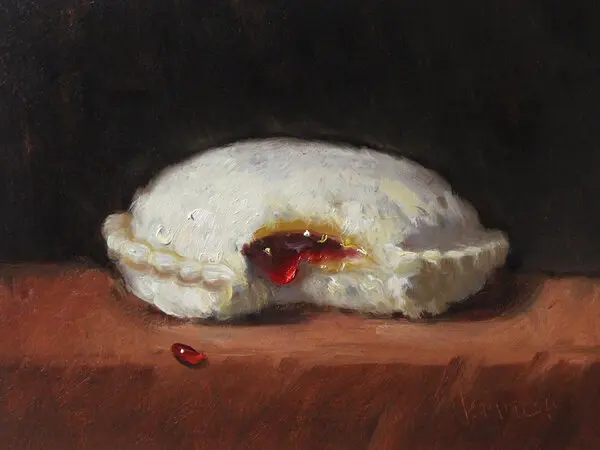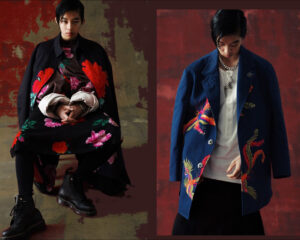In the dynamic and often unpredictable world of contemporary art, where the boundaries between highbrow and lowbrow culture are continuously blurred, Noah Verrier has made a name for himself by painting what most would consider unremarkable subjects: junk food. However, what sets Verrier apart from other artists working in the realm of still life is the way he elevates these mundane, everyday objects into the realm of fine art. His recent success, notably the sale of an oil painting of a Smucker’s Uncrustables sandwich for nearly $5,000, has sparked conversations about the intersection of consumer culture, artistry, and the hierarchy of subject matter in the world of fine arts.
Through a closer examination of Verrier’s work, including his unique approach to painting, his choice of subjects, and his ability to merge the styles of traditional still life painting with contemporary commentary on consumerism, we can gain a better understanding of why his art has resonated so strongly with both critics and collectors.
The Artist: Noah Verrier and His Background
Noah Verrier, a 44-year-old artist from Tallahassee, Florida, has garnered attention on social media for his meticulously crafted oil paintings of everyday food items. His chosen subjects—ranging from cheesesteaks and soda cans to chicken nuggets and PB&J sandwiches—may seem trivial at first glance, but Verrier’s approach to these humble objects is anything but ordinary.
Verrier is classically trained and uses traditional oil painting techniques to create his works, drawing from a rich history of still life painting that dates back to the Dutch Golden Age. His use of the “alla prima” technique, which involves painting wet-on-wet without allowing earlier layers of paint to dry, adds a sense of immediacy and freshness to his work. This technique was popularized by the Impressionists, who sought to capture the fleeting quality of light and atmosphere in their paintings, and Verrier applies it to the glossy surfaces and vibrant colors of fast food, imbuing his subjects with a richness and texture that elevates them beyond mere representation.
The contrast between Verrier’s classical painting style and his contemporary subjects forms the foundation of his artistic approach. By applying delicate brushstrokes and layering paint to depict greasy, processed food, Verrier is able to evoke a sense of nostalgia and familiarity while also inviting viewers to reconsider their relationship with these objects.
The Subject Matter: Junk Food in High Art
One of the most striking aspects of Verrier’s work is his choice of subject matter. Food has long been a popular subject in art, from the lavish banquet scenes of Renaissance Europe to the carefully arranged still lifes of 17th-century Dutch painters. In these classical works, food was often used as a symbol of wealth, abundance, or even moral lessons about the fleeting nature of life, as in the case of “vanitas” paintings. In contrast, Verrier’s subjects—mass-produced, processed foods such as cheeseburgers, potato chips, and soft drinks—represent something entirely different.
Junk food is a product of modern consumer culture, emblematic of convenience, excess, and mass production. It is often viewed as lowbrow, disposable, and even unhealthy. By choosing to paint these items, Verrier deliberately plays with the tension between high and low culture. His work challenges the traditional notion of what is considered worthy of fine art, drawing attention to the beauty that can be found in even the most mundane and overlooked aspects of modern life.
One of the most iconic pieces in Verrier’s oeuvre is his oil painting of a Smucker’s Uncrustables sandwich. At first glance, it may seem absurd that such a simple and unassuming object would be the subject of a fine art painting, let alone one that sold for nearly $5,000 at auction. However, the painting’s appeal lies in the way Verrier elevates this mass-produced sandwich into something worthy of aesthetic contemplation. His careful attention to detail—the soft texture of the bread, the glossy sheen of the peanut butter and jelly—transforms the sandwich into a symbol of nostalgia and childhood, as well as a commentary on the way food is commodified in contemporary society.
The Process: Connecting with the Subject
One of the most fascinating aspects of Noah Verrier’s artistic process is his commitment to fully immersing himself in his subject matter. In interviews, Verrier has stated that he makes a point of eating the food items he paints before beginning his work. This act of consumption adds an extra layer of authenticity to his paintings, as it allows him to connect with his subjects on a personal level.
By eating the food, Verrier is engaging in the same ritual that millions of people around the world partake in daily: the consumption of fast, convenient meals. However, in the context of his art, this act takes on new significance. Eating the food becomes a way for Verrier to better understand its texture, color, and form, which he then translates into paint. In doing so, he captures not only the physical qualities of the food but also the experience of consuming it.
This connection between artist and subject adds a layer of intimacy to Verrier’s work. While the food he paints may be mass-produced and impersonal, his act of consuming it before painting creates a personal connection that is reflected in the care and attention he gives to each piece. This process of consumption and creation mirrors the broader consumer culture in which these food items exist, making Verrier’s work not just a commentary on junk food itself but on the way we relate to and consume everyday objects in our lives.
The Style: A Modern Take on Classical Techniques
At the heart of Verrier’s work is his use of the *alla prima* technique, a method of painting that involves applying wet paint directly onto wet layers without waiting for each layer to dry. This technique allows for a more fluid and spontaneous approach to painting, which is well-suited to Verrier’s subjects. The *alla prima* technique, though traditionally associated with Impressionism, lends itself surprisingly well to the representation of contemporary objects such as fast food.
The wet-on-wet application of paint creates a soft, almost tactile quality in Verrier’s works, which is particularly effective in capturing the textures of food. For example, in his paintings of hamburgers, the softness of the bun, the greasiness of the cheese, and the crispness of the lettuce are all rendered with meticulous detail, making the viewer feel as though they could reach out and touch the food. This level of realism, combined with the expressive brushstrokes of “alla prima”, gives Verrier’s paintings a distinctive quality that sets them apart from traditional still lifes.
In addition to his technique, Verrier’s use of light and color plays a crucial role in the impact of his work. Like the Dutch masters of the 17th century, Verrier often employs dramatic lighting to highlight his subjects, creating a sense of depth and volume. The rich, saturated colors he uses are reminiscent of the high-sugar, high-fat content of the food he paints, further emphasizing the allure and indulgence of these everyday items.
The Cultural Commentary: Highbrow Meets Lowbrow
Noah Verrier’s work occupies a unique space at the intersection of high and low culture. By applying classical painting techniques to lowbrow subjects like junk food, he blurs the line between these two realms, forcing viewers to reconsider what is considered “worthy” of fine art. His work speaks to the broader cultural conversation about the hierarchy of taste and the ways in which consumerism has shaped our relationship with food and art.
The elevation of junk food to the status of fine art is both humorous and thought-provoking. On one hand, it highlights the absurdity of modern consumer culture, where mass-produced, disposable objects are consumed and discarded without much thought. On the other hand, it invites viewers to see beauty in the everyday, to find value in the mundane, and to appreciate the artistry that goes into even the most common objects.
Verrier’s work also raises questions about the role of nostalgia in contemporary culture. Many of the food items he paints, such as Uncrustables sandwiches and chicken nuggets, are associated with childhood and comfort. By rendering these objects in oil paint, Verrier taps into the emotional connection that many people have with junk food, turning them into symbols of innocence, indulgence, and the passage of time. In this way, his work is not just about the food itself but about the memories and emotions that these foods evoke.
The Art Market: Success and Reception
The art world has taken notice of Noah Verrier’s unique approach to still life painting. His work has gained popularity on social media, where he regularly shares images of his paintings and engages with his audience. His social media presence has helped to build a strong following of fans who appreciate the humor, skill, and cultural commentary embedded in his work.
In addition to his online success, Verrier’s paintings have attracted serious attention in the art market. The sale of his Smucker’s Uncrustables painting for nearly $5,000 at auction is a testament to the growing interest in his work. This success suggests that there is a demand for art that bridges the gap between highbrow and lowbrow culture, particularly in the realm of still life painting.
Critics have praised Verrier’s ability to elevate everyday objects through his classical painting techniques, while also acknowledging the playful and irreverent nature of his subject matter. His work is seen as a fresh take on a traditional genre, one that challenges the conventions of still life painting while also celebrating the beauty of the mundane.
Noah Verrier’s paintings of junk food offer a unique and thought-provoking take on the tradition of still life painting. By combining classical techniques with contemporary subjects, he creates works that are both visually stunning and culturally relevant. His use of the “alla prima” technique, along with his commitment to connecting with his subjects through consumption, adds an extra layer of depth and authenticity to his work.
At its core, Verrier’s art is about finding beauty in the everyday. Whether through a detailed rendering of a cheeseburger or a lovingly painted Smucker’s Uncrustables sandwich, his work invites viewers to reconsider the objects that populate their daily lives and to appreciate the artistry that can be found in even the most unexpected places. As his popularity continues to grow, Noah Verrier is undoubtedly a rising star in the world of contemporary still life painting, offering a fresh perspective on both art and the culture of consumption.
No comments yet.








